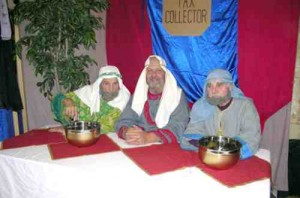Review by Ed Quillen
Biography – December 2008 – Colorado Central Magazine
Speck – The Life and Times of Spencer Penrose
by Robert C. Olson
Published in 2008 by Western Reflections
ISBN 978-1-932738-50-6
FEW MEN have enjoyed such dashing lives as Spencer Penrose did from his birth in Philadelphia on Nov. 2, 1865 until his death on Dec. 7, 1939 at El Pomar, his palatial estate on the west side of Colorado Springs.
Even fewer have left such a philanthropic legacy as he did with the El Pomar Foundation, which donates $25 million a year to worthy causes, many in this part of Colorado; for instance, it was a major donor to the Salida Regional Library’s building addition a dozen years ago. There are also the Salida Steamplant Theater, the St. Joseph’s Great Hall, and the new Salida Hospital — just to name a few from the foundation’s 2006 report.
Spencer’s family roots were upper-crust Philadelphia, going back to colonial times. His father, Richard Alexander Fullerton Penrose, was a prosperous obstetrician married to Sarah Hannah Boies Penrose. They had five sons that survived childbirth: Boies, Carles, Dick, Speck, and Frances.
All received excellent educations, starting with private tutors and extending through Harvard. Three attained distinction. Boies became a U.S. senator from Pennsylvania (often attacked as a reactionary, though). Dick became an eminent geologist, so esteemed that the highest award of the Geological Society of America is the Penrose Medal in his honor. Speck went out west to get rich, and boy did he.
(Generally, I’ve seen his nickname spelled as “Spec” instead of “Speck,” but as long as the author is consistent, which Olson is, either is fine by me).
Speck got to Colorado Springs in 1892, where he met up with an old Philadelphia family friend, Charles Leaming Tutt, who was in the real-estate business at the foot of Pike’s Peak. Even then, Speck presented himself distinctively — neatly trimmed mustache, broad-brimmed hat, English-style riding breeches and boots.
Speck also had a thirst for whiskey, and the Springs was a temperance town in those days. So Tutt took him out to the Cheyenne Mountain Country Club, just past the Broadmoor Dairy Farm.
Cripple Creek was starting to boom on account of gold discoveries; Penrose and Tutt invested in its real estate, and then a gold mine, the C.O.D. They sold it at a profit, and Speck got into milling and refining. He ran with a fast crowd in Cripple Creek, a group known as “the Socialites” who drank hard and caroused at the whorehouses.
Penrose used Cripple Creek profits to bankroll Daniel C. Jackling, a metallurgist who found a new way to mine copper. Rather than follow high-grade veins, they moved and milled vast tonnages of low-grade rock.
The resulting Utah Copper Company mine at Bingham Canyon made Penrose a multi-millionaire, and he set out to live well and enjoy life. Some of his pleasure came from one of his enduring creations, the Broadmoor Hotel and associated resort of Colorado Springs. In 1906, he married a widow, Julie McMillan, who had a daughter from her first husband. They lived and traveled on a grand scale.
In brief, that’s the life of Spencer Penrose, and this biography conveys it clearly and well. Speck was a remarkable character, as this book demonstrates, but it doesn’t gloss over Speck’s role as a union-buster and fierce foe of the working class of that era. To his credit, Olson presents Spencer in full.
As for nit-picking, only one error jumped at me in this book. Several times, it characterizes the Cripple Creek Shortline Railroad (or the Colorado Springs & Cripple Creek District) as narrow-gauge, when in fact it was standard-gauge. And I wish Speck had an index, because this is the kind of book one would like to keep around for reference, such as finding out whether the settlement of Penrose, northeast of Cañon City, was named for him (it was, as it was one of his real-estate ventures).
To say the least, Speck Penrose led a full and interesting life, and unlike many of his fellow robber barons, he left a charitable endowment that has benefited scores of community enterprises, the El Pomar Foundation. So he’s well worth reading about, and this biography tells the story pretty well.

